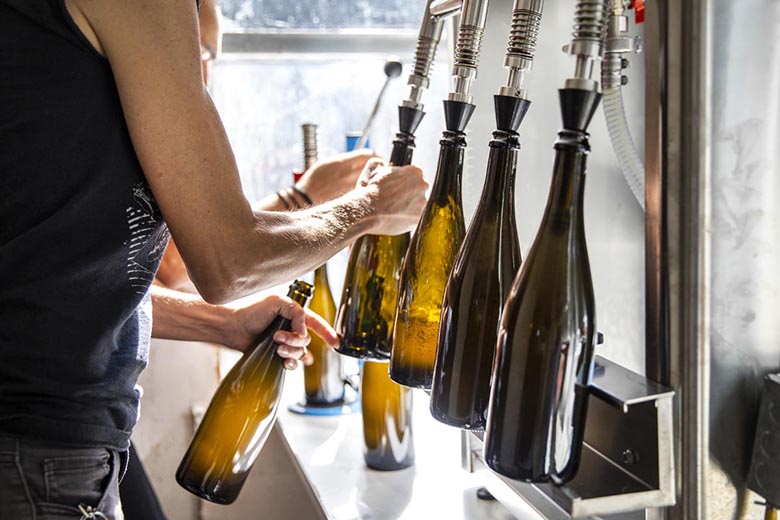
“We have an enormous garden that has become a weed garden,” says Kimberly Kae. While this one patch may have escaped her control, the long-neglected 45-tree orchard on the property of Kae and her husband, Matt DiFrancesco, hasn’t. They’ve successfully revived it in recent years to build Metal House: their tiny, esteemed cidery in Esopus, New York.
Even with an expansion to a nearby orchard (which Kae and DiFrancesco also resuscitated after decades of dormancy), Metal House distributes well under 10 thousand bottles each year. About 75 percent of those bottles end up in the city because their dedication to creating cider by hand without extensive commercial equipment or short cuts has captured the imagination of chefs and restaurateurs across the city.
As is fairly common for craft ciders, Metal House is made in the méthode champenoise tradition that builds flavor through multiple fermentations and aging directly on the lees (aka yeast cells and sediment that settle out of solution during fermentation). It’s precise work that, beginning with the fruit, is an extension of their personal philosophies.

“We don’t use conventionally farmed fruit,” says Kae, “[and] we never use fruit that is already picked.”
Kae and DiFrancesco do most of the picking themselves, usually from their own orchard or orchards nearby that they have painstakingly restored. Once the fruit is picked, the meticulous work of sorting it begins.
“We check each apple to make sure it’s in good shape, we’ll cut pieces out or open them [the apples] up.”
Practices like this, touching each and every apple, create a quality that commercial cider can’t replicate.

“It’s very elegant,” says chef Alex Raij, whose restaurant, St. Julivert, in Brooklyn, carries Metal House on the menu. “Her [Kae’s] cider is very boutique and so is our restaurant. They really go together.”
So boutique, that the apples are pressed on a rack and cloth press that DiFrancesco built by hand. It takes up to six hours to press about 140 gallons of juice, enough to make roughly 700 bottles of cider.
“When we’re pressing, you can smell what’s happening right away. You can smell the notes of the apple, their flavors,” says Kae. Later, after the first fermentation, the pressed juices of these apples will be thoughtfully blended before they are fermented again, an important part of Champagne-style cider making.

“I look for ciders that have a quality like those ciders from Brittany and Normandy [France] that have the qualities of being blended … and have that really dry finish,” says Mike Anthony, executive chef of Gramercy Tavern.
“The ciders that Metal House makes, they are the best of all of the worlds. They are made slow and in the Champagne method. They use a wide variety of historic apples, and they blend,” Anthony says. “They resonate with me, personally.”
It’s not just Gramercy Tavern that has given Metal House’s ciders a coveted spot on the beverage menu: Restaurants around the city, including hot spots like Frenchette in TriBeCa, Egg in Williamsburg, Murray’s Cheese Bar in the West Village and the aforementioned newly opened St. Julivert in Cobble Hill carry their lightly sparkling wares.
“People come for it [Metal House] asking by name. They come in after tasting it in restaurants, and that’s happening more often,” says Mary Dudine, co-owner of Dry Dock Wine + Spirits in Red Hook.

Dudine has known Kae and DiFrancesco since long before the days of Metal House and started carrying their ciders as soon as they were available.
“It’s one of those great things that you can give a customer that’s looking for something really different and “very special,”’ says Dudine. “I’ll tell them, ‘Forget that lighter-bodied Burgundy, take this home.’ It’s something people want to sip slowly.”
As those slow sippers enjoy the cider, they’ll be met with floral and fruity aromatics, a dry finish and hints of wildness that come from lesser-known apple varieties like golden russet and goldrush—brought to life in a glass.



